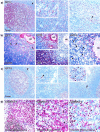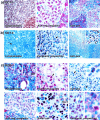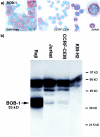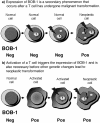Expression of B-lymphocyte-associated transcription factors in human T-cell neoplasms
- PMID: 12598320
- PMCID: PMC1868085
- DOI: 10.1016/S0002-9440(10)63882-5
Expression of B-lymphocyte-associated transcription factors in human T-cell neoplasms
Abstract
In this study we have investigated the expression of three B-cell-associated transcription factors in normal lymphoid tissue and in T-cell neoplasms (three cell lines, and more than 50 biopsy samples). Nuclear OCT-1 immunoreactivity was seen in normal B cells, in many extrafollicular T cells, and in a heterogeneous pattern (ranging in intensity from weak to moderate) in most T-cell neoplasms. OCT-2 immunostaining was primarily restricted in normal lymphoid tissue to B cells, and was absent from most T-cell neoplasms. In contrast, immunostaining for BOB-1/OCA-B--essentially restricted to B cells in normal lymphoid tissue, with the exception of activated T-lymphocytes--was seen in all of the T-cell lines tested and the majority of the tumor cells in all categories of T-cell lymphoma. Thus labeling for each of these three B-cell-associated transcription factors can be seen to varying degrees in T-cell neoplasms. However, the high frequency of BOB-1 expression in T-cell neoplasms, in contrast to its absence from resting peripheral T cells, suggests that its expression might be a prerequisite for neoplastic transformation, and prompts a search for the transcriptional target(s) of this factor in T cells.
Figures





Similar articles
-
Differentiation of human B-cell malignant lymphomas is independent of the octamer lymphoid specific binding factor (Oct-2).Immunology. 1991 Sep;74(1):37-43. Immunology. 1991. PMID: 1937571 Free PMC article.
-
Lymphoid-specific transcription mediated by the conserved octamer site: who is doing what?Semin Immunol. 1998 Apr;10(2):155-63. doi: 10.1006/smim.1998.0117. Semin Immunol. 1998. PMID: 9618761 Review.
-
A novel octamer regulatory element in the VH11 leader exon of B-1 cells.J Immunol. 1995 May 1;154(9):4546-56. J Immunol. 1995. PMID: 7722308
-
The B cell coactivator Bob1 shows DNA sequence-dependent complex formation with Oct-1/Oct-2 factors, leading to differential promoter activation.EMBO J. 1996 Jun 3;15(11):2781-90. EMBO J. 1996. PMID: 8654375 Free PMC article.
-
A B-cell coactivator of octamer-binding transcription factors.Nature. 1995 Jan 26;373(6512):360-2. doi: 10.1038/373360a0. Nature. 1995. PMID: 7779176
Cited by
-
Programmed death-1 (PD-1) is a marker of germinal center-associated T cells and angioimmunoblastic T-cell lymphoma.Am J Surg Pathol. 2006 Jul;30(7):802-10. doi: 10.1097/01.pas.0000209855.28282.ce. Am J Surg Pathol. 2006. PMID: 16819321 Free PMC article.
-
The phosphatidylserine receptors, T cell immunoglobulin mucin proteins 3 and 4, are markers of histiocytic sarcoma and other histiocytic and dendritic cell neoplasms.Hum Pathol. 2010 Oct;41(10):1486-94. doi: 10.1016/j.humpath.2010.04.005. Epub 2010 Jul 24. Hum Pathol. 2010. PMID: 20656318 Free PMC article.
-
The Role of the Transcriptional Coactivator BOB.1/OBF.1 in Adaptive Immunity.Adv Exp Med Biol. 2024;1459:53-77. doi: 10.1007/978-3-031-62731-6_3. Adv Exp Med Biol. 2024. PMID: 39017839 Review.
-
BOB.1/OBF.1 controls the balance of TH1 and TH2 immune responses.EMBO J. 2007 Jul 11;26(13):3191-202. doi: 10.1038/sj.emboj.7601742. Epub 2007 Jun 14. EMBO J. 2007. PMID: 17568779 Free PMC article.
References
-
- Henderson A, Calame K: Transcriptional regulation during B cell development. Annu Rev Immunol 1998, 16:163-200 - PubMed
-
- Kuo CT, Leiden JM: Transcriptional regulation of T lymphocyte development and function. Annu Rev Immunol 1999, 17:149-187 - PubMed
-
- Wirth T, Pfisterer P, Annweiler A, Zwilling S, Konig H: Molecular principles of Oct2-mediated gene activation in B cells. Immunobiology 1995, 193:161-170 - PubMed
-
- Matthias P: Lymphoid-specific transcription mediated by the conserved octamer site: who is doing what? Semin Immunol 1998, 10:155-163 - PubMed
Publication types
MeSH terms
Substances
LinkOut - more resources
Full Text Sources

